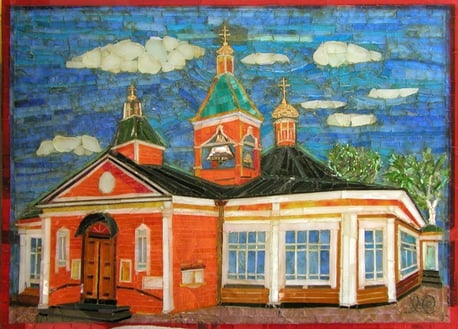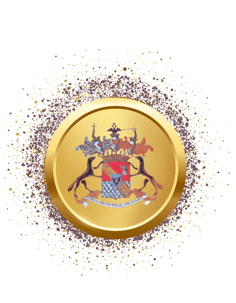History of Stroganov Family
It is believed that the Stroganoff family originated in Northwestern Russia, from Veliky Novgorod. There was, however, a legend about a Tatar ancestor of the Stroganovs, a relative, perhaps even a son of the Khan of the Golden Horde, who allegedly went to serve Prince Dmitry Donskoy, married a relative of Dmitry Donskoy, converted to Christianity and change the name to Spiridon at baptism. Subsequently he refused to return to the Horde, was captured by the Tatars and literally cut into pieces. This information is based on the story of the Dutch scholar, burgomaster Nicholas Witzen, who borrowed his account of the origin of the Stroganovs from the Dutch geographer Isaac Massa, who wrote about Russia in 1609. The date of martyrdom of Spiridon in Stroganov's genealogy is referred to 6903 on old chronology (or to 1395 on a modern calendar).
The son born after Spiridon's death was named Kozma and he was given the surname Stroganov (from the word “planing” in Russian).
There are other versions of the origin of the ancestor of the Stroganovs, Spiridon, who could have been a descendant of rich Pomor peasants, although such stories were extremely rare. His great-grandson Fyodor Stroganov, with his sons, began to develop new lands and moved to Solvychegodsk, where he continued to engage in salt fisheries. Fyodor's son, Anika, expanded the Stroganov family's holdings in Perm, Kama and Trans-Urals. In 1558 he received vast lands along the Kama and Chusovaya rivers from Tsar Ivan IV the Terrible. There was historical evidence that Anika developed a plan to annex Siberia to the Russian Empire.
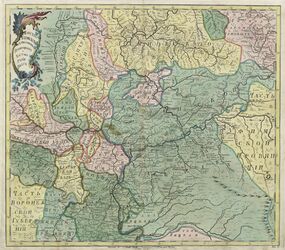

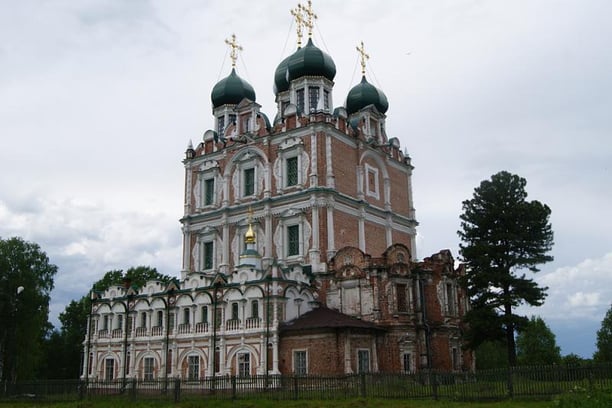

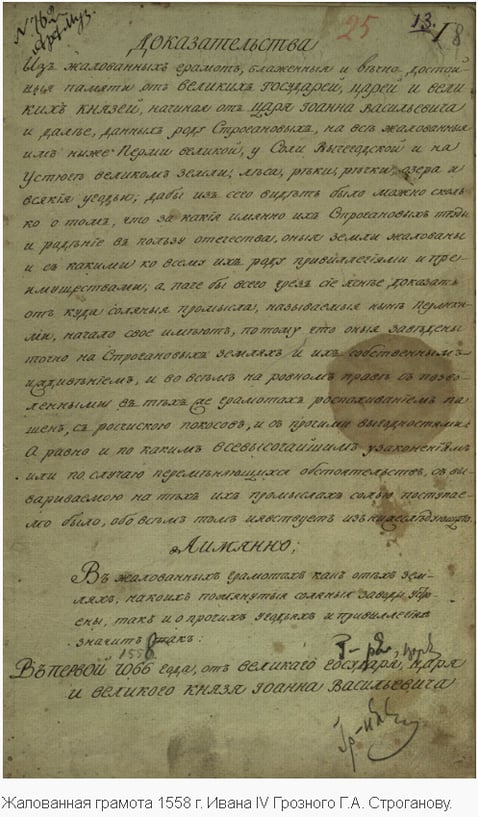

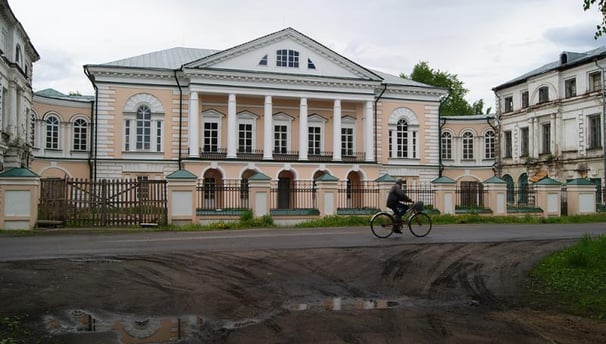

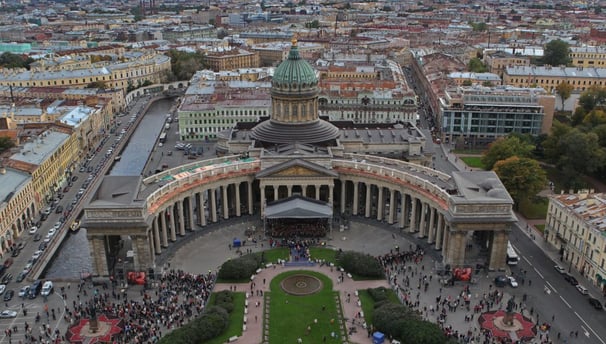

In 1572, by Tsar’s decree, the Stroganovs were given the right to create their own army “under a good commander” in order to subdue the hostile Siberian nomads to the Russian Tsar. Anika was very religious, built several churches with his own money and made generous donations to monasteries. In his old age he withdrew from the world and tonsured himself as a monk, taking the monastic name Joseph.
By the time of family ownership in 1579, the Stroganovs owned more than 3.5 million acres of land alone. Semyon Annikievich, as the eldest member of the family, stayed on the settled Stroganov lands in Solvychegodsk, and Anika's grandsons Maxim and Nikita got the Kama, Perm and Trans-Ural territories. They had to build fortified towns and to keep a large number of military force for defense against raids of local tribes.
At the same time they hired Yermak and his Cossack army. In 1581 Maxim Yakovlevich and Nikita Grigorievich Stroganov fully equipped a large military detachment led by Yermak for a campaign to Siberia. The purpose of this campaign was to destroy the power of Khan Kuchum in Siberia. According to the Tsar's charter, the Stroganovs had the right to go to war in Siberia without asking permission to do so. In addition, the Stroganovs actively helped the state by providing their army and donating significant sums to the treasury. Yermak's campaign was successful, Yermak inflicted a crushing defeat on Kuchum Khan and occupied his capital.
Grigory (1656-1715), grandson of Semyon, remained the sole heir to all of the Stroganovs' innumerable estates. Just like his predecessors, Grigory Dmitrievich Stroganov gave wide support to state endeavors, in particular during the Great Northern War, when, in addition to monetary donations, Grigory Stroganov built and equipped a frigate at his own expense.
Grigory Stroganov was the last person to bear the title of “distinguished man”, as in 1712 Tsar Peter the Great granted his sons the title of baron for the merits of their ancestors.
At first the lands were granted to the Stroganovs only for temporary possession, but each new sovereign on ascending to the throne invariably confirmed their rights to everything previously granted to them; the all-powerful contemporary of Peter the Great, Grigory Dmitrievich Stroganov, sought from this sovereign a charter confirming him and his heirs in perpetual possession of all estates. During the Northern War of 1700-1721, the Stroganovs provided significant funds to Peter The Great, founded a number of ironworks and other factories in the Urals. Alexander, Nikolai and Sergey Stroganovs, sons of Grigory Dmitrievich, were not only the first barons in the family, but also the first members of the family to enter public service. Their wealth and personal qualities earned them a high place at court.
Alexander Grigorievich was an educated man and, like all members of his family, a generous benefactor. His brother Sergei Grigorievich was also a connoisseur and patron of art. In his house, built by famous architect Rastrelli himself, Sergei Grigorievich founded a beautiful art gallery.
The descendants of Barons Stroganov, brothers Nicholas and Sergei Grigorievich, also played a significant role at court and in the state. The only son of Sergei Grigorievich, Alexander Sergeevich Stroganov (1733-1811), earned the gratitude of his contemporaries and descendants as the most famous patron of arts and science. He traveled extensively in Western Europe, brilliantly mastered several languages, attended lectures of the best European professors in Geneva for two years, especially interested in history. The Austrian Empress Maria Theresa granted him the title of Count of the Holy Roman Empire in 1761.
In 1800 Stroganov became President of the Academy of Arts, and it was truly a golden time for the Academy. Stroganov generously helped young talents, financing their education abroad largely from his own capital.
Alexander Sergeyevich Stroganov was one of those rare people who managed, being in the thick of court life, not to participate in any political intrigues. Thanks to his benevolent character, he managed to retain his position at court during the next change, when Tsar Paul ascended the throne. In 1798 Stroganov received from the title of Count of the Russian Empire from Tsar Paul the First And in the reign of Alexander the First Stroganov continued to enjoy the Emperor's favor.
Alexander Sergeyevich made life easier for a huge number of peasants - only in Stroganov's Perm estates there were more than eighteen thousands of them. Being a senator, Stroganov repeatedly raised the issue of establishing schools for them. The talented Russian architect Voronikhin came from Stroganov's serfs.
The last ten years of Alexander Stroganov's life were devoted to the construction of the Kazan Cathedral in St. Petersburg, in which a lot of his own money was invested. Such a wide charitable activity, which required huge monetary expenditures, upset Stroganov's capital, and his son Paul inherited significant debts.
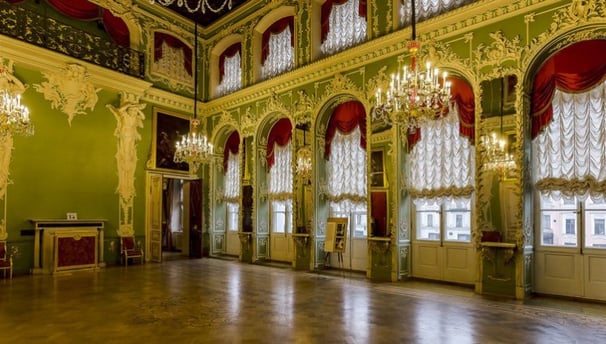

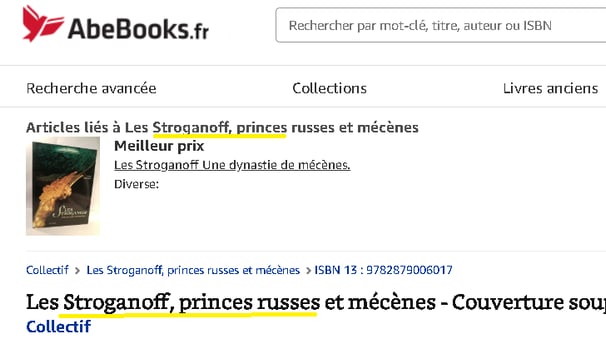

Many sources report that the last of those Stroganovs who left Russia, Count Sergei Alexandrovich, philanthropist, horse breeder and naval officer, died in 1923 in France. He had no heirs left. However, in France people appeared who declared themselves “the only heirs of the family” and apparently seized the exported works of art from the Stroganovs' collection. These people had no proof of relations to the family, officially they bore quite different surnames, but persistently called themselves by other names and actively publicized themselves as “Stroganov’s heirs”, including for the Media both in Russia and France.
Priceless works of art helped them to lead a trouble-free life and even attract a lot of attention to themselves by organizing exhibitions. For example, there had been the artworks exhibition in Paris called “Prince Stroganoff”, and subsequently a book was published. It goes without saying that the real Stroganovs categorically object to the misspelling of their glorious family name, and they know that Stroganovs were never princes. Everyone familiar with the history of the Stroganov family as well as historians know that.
Of course, it would be much better if the works of art were left for the public museum, where they could be seen by millions of people. Numerous descendants of the Stroganovs continue to live in Russia and many other countries, and the goal of this website it to unite them as a large family. Life goes on.
In 1807, during the Swedish War, Paul, already a senator and occupying a very high position, he volunteered to join the Life Guards. As commander of the grenadier regiment, he demonstrated great courage, and later took part in battles with the French at Borodino, Craon and Paris. His only son Alexander died in the battle of Craon. This grief undermined Pavel Alexandrovich's health, and he died in 1817. Thus this branch of the Stroganoff family was interrupted in the male line. His daughter, Natalia Pavlovna Stroganova, married her distant relative, the famous Russian educator Sergei Grigorievich Stroganov, and the title of count passed to him. A great lover and connoisseur of painting and sculpture, Sergei Grigorievich Stroganov also left his memory as the founder of the first Russian drawing school. In 1825 he organized the now famous Stroganov School of Art in Moscow.
Nikolai Grigorievich (1700-1758), the middle of three brothers, sons of the famous Grigory Dmitrievich Stroganov, had three sons and three daughters. His daughter Maria married Count Skavronsky, and the Stroganovs became related to the reigning house.
The descendants of Nikolai Grigorievich Stroganov were, like their predecessors, well-known people in Russia, prominent statesmen and public figures. One of them, Grigory Alexandrovich Stroganov (1770-1857), was in the diplomatic service in Sweden and Spain, and was ambassador to Turkey. In 1826, on the day of his coronation, Emperor Nicholas 1 granted him the title of Count. Grigory Dmitrievich's middle son, Nikolai Grigoryevich, had numerous descendants, still alive today.
Count Alexander Grigorievich Stroganov (1795-1891), son of Grigory Alexandrovich, after graduating from the Corps of Railway Engineers, successfully began his military career and during the war with Napoleon as a member of the Artillery Brigade General participated in many battles, including at Leipzig and Dresden, and in the capture of Paris. For a long time, he was the Governor-General of Novorossiysk and Bessarabia. Alexander Grigorievich Stroganov was the President of the Odessa Society of History and Antiquities of Russia, provided generous assistance to the Odessa Museum. He bequeathed his library to Tomsk University.
Another prominent representative of this family, Sergei Grigorievich Stroganov (1794-1882), was in military service all his life, showed great courage at the Battle of Borodino and took part in the Crimean War of 1854-1855. Thanks to his noble qualities of mind and deep education, Sergei Grigorievich Stroganov was elected tutor of the Tsar's sons, Grand Dukes Nicholas, Alexander, Vladimir and Alexei Alexandrovich.
In 1825 Sergei Grigorievich founded the first drawing school in Moscow at his own expense. From 1835 to 1847 he was a trustee of the Moscow educational district.
Sergey Grigorievich Stroganov had a passion for history and archaeology. For more than thirty years he served as Chairman of the Society of History and Antiquities of Russia at Moscow University, he was also the founder of the Archaeological Commission, which on his initiative conducted excavations in the south of Russia and on the Black Sea coast. Historical works by other authors were also printed at Stroganov's expense. Stroganov's interests also included collecting works of painting, and he significantly contributed to the family gallery. He was also a great connoisseur of ancient icon painting and amassed a rich collection of ancient icons.
Many of the Stroganovs are known not only for their entrepreneurship, active charity, but also for their interest in art, literature, history and archeology. The Stroganovs had the richest libraries, collections of paintings, coins, prints, medals, etc.
The Stroganovs fully justified their motto in Latin: “I will bring wealth to the Fatherland and leave a name for myself”. Their history has always been closely intertwined with the history of the Russian State. However, as in every family, there were sad stories, one of which stretched almost to our days.
After the October Revolution of 1917, the property of the Stroganovs was nationalized. Thus, on January 5, 1918 the Ural Regional Council decided to nationalize the Bilimbayevsky plant. On February 6, 1918, the Perm Regional Executive Committee issued a decree regarding the Stroganov estate in the village of Ilyinsky, where the head office of the Perm property of the Stroganovs was located, according to which "all agricultural, forest, water and industrial lands, which are the national property, are transferred to the jurisdiction and disposal of the land committees”. On February 10, 1918 the RSFSR All-Union Council of National Economy adopted Resolution No. 779 “On nationalization and organization of management of enterprises in the Urals”, according to which the “Perm estates of Counts Stroganov (Dobryanka, Bilimbay, Utka, Ilyinskoye, Ochersky Kyn, etc.)” were subject to nationalization. In the spring of the same year, measures are taken to nationalize the Dobryanka, Utka and saltworks. On July 31, 1918 the Stroganov Palace was proclaimed a national property.
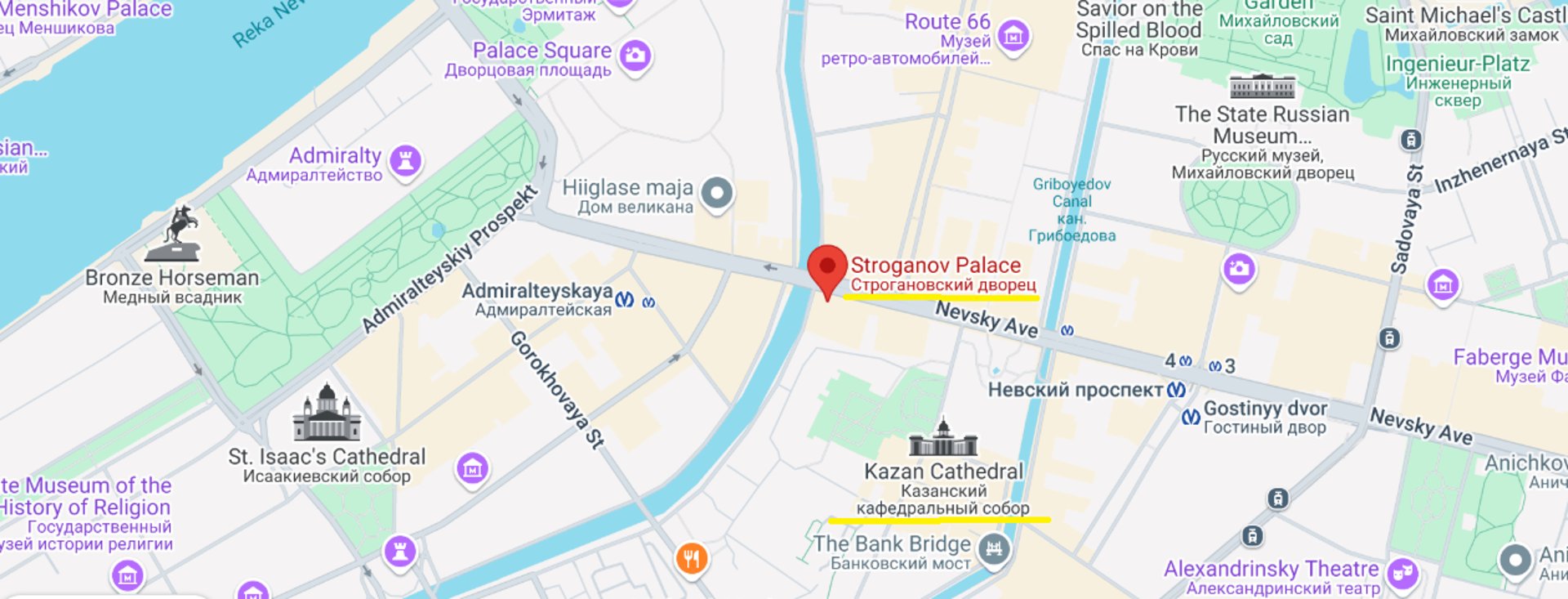
Coat of Arms
The shield is horizontally divided, has two parts, of which in the upper part in a red field is a silver bear's head facing right. In the lower part there is white fur, in the same shield from the upper right corner to the lower left corner there is a golden wavy belt with four iron spears and in the middle of it there is a small blue shield, in which is depicted a crowned eagle holding in its paws a sceptre and orb, having on its breast in the small blue shield the monogram of His Majesty the Emperor Nikolay The First. The shield is surmounted by a count's crown, on the surface of which are three helmets crowned: the middle one with a count's crown and the outer ones with noble crowns, of which the middle one has a black double-headed crowned eagle, and the outer ones have one hand in silver armor, holding a golden cross on the right side and a sword on the left. The armor on the shield is silver and gold, lined with blue and red. The shield is held by two sables. Under the shield is the motto: “Ferram opes patriae, sibi nomen” (“I will bring wealth to my fatherland, I will leave a name for myself”). The coat of arms of Count Stroganov (Strogonov) is included in Part 10 of the General Armorial of noble families of the All-Russian Empire, page. 12.
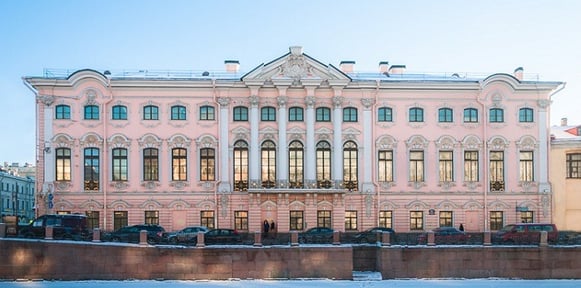

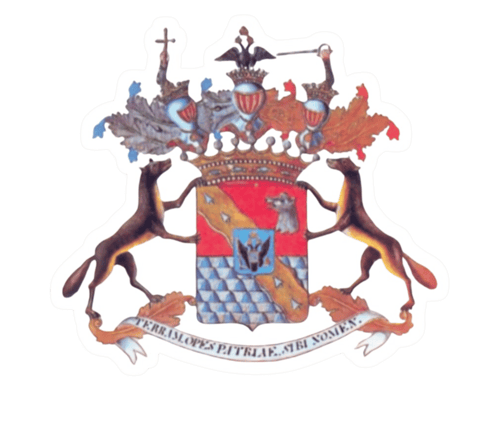

Palaces and Estates
- Baron Sergei Grigorievich Stroganov built the Stroganov Palace on Nevsky Prospekt.
- Count Alexander Sergeevich Stroganov (1733-1811) built the Stroganov Dacha in St. Petersburg and the Bratzevo estate near Moscow.
- Count Pavel Alexandrovich Stroganov (1774-1817) and his wife Countess Sophia Vladimirovna, née Princess Golitsyna, built the estate of Maryino, now located in the Tosnensky district of the Leningrad region.
Links and references
М. Гавлин. Российские предприниматели и меценаты
Строгановы: 500 славных лет | RATNIK.TV
Сольвычегодск и Строгановы. Немного истории
Строгановы — титулы дворянского рода, известные представители, подданство — РУВИКИ
Read online «Строгановы: история рода», Татьяна Меттерних – LitRes
Dissertatsiya_Prizyuk-V.YA.-.pdf
У кого из известных людей были татарские корни?
Иван Грозный. Часть 4. Окончание. Глава 3. Покорение Сибири. Ермак. II. Строгановы. Автор произведения - Валишевский К. Ф.. Иностранная литература.
Освоение Сибири | Смотреть видеолекции по истории РФ для школьников и студентов
Les Stroganoff, princes russes et mécènes - Collectif: 9782879006017 - AbeBooks
Denis Auguste Marie Raffet (1804-1860) , Portrait of Prince Stroganoff | Christie's
Сольвычегодск, Часовня-усыпальница Строгановых
Российская национальная библиотека и Александро-Невская лавра: Лазаревское кладбище. Фотографии
Кенотаф баронов Строгановых при церкви Николая Чудотворца в Котельниках (Москва)
30 House of stroganov Images: PICRYL - Public Domain Media Search Engine Public Domain Search
ЖАЛОВАННАЯ ГРАМОТА СТРОГАНОВЫМ 1591 ГОДА. DrevLit.Ru - библиотека древних рукописей
Библиотеки Строгановых в Усолье | Березниковский историко-художественный музей им. И.Ф. Коновалова
«Богаче не будешь». Как Григорий Строганов помогал деньгами Петру I | АиФ Санкт-Петербург
© 2025. All rights reserved.
